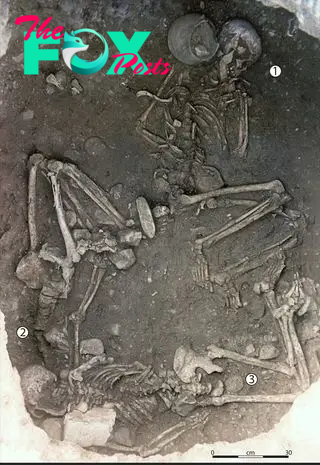Archaeology
Neolithic women in Europe were tied up and buried alive in ritual sacrifices, study suggests
The murder of sacrificial victims by "incaprettamento" — tying their neck to their legs bent behind their back, so that they effectively strangled themselves — seems to have been a tradition across much of Neolithic Europe, with a new study identifying more than a dozen such murders over more than 2,000 years.
The study comes after a reassessment of an ancient tomb that was discovered more than 20 years ago at Saint-Paul-Trois-Châteaux near Avignon, in southern France. The tomb mimics a silo, or pit where grain was stored, and it held the remains of three women who were buried there about 5,500 years ago.
The new study, published Wednesday (April 10) in the journal Science Advances, reinterprets the positions of two of the skeletons and suggests the individuals were deliberately killed — first by tying them up in the manner called "incaprettamento" and then by burying them while they were still alive, perhaps for an agricultural ritual.
Study senior author Eric Crubézy, a biological anthropologist at Paul Sabatier University in Toulouse, France, told Live Science that there was a lot of agricultural symbolism to the tomb. He noted that a wooden structure built over it was aligned with the sun at the solstices and that several broken stones for grinding grain were found nearby. "You have the alignment, you have the silo, you have the broken stones — so it seems that it was a rite related to agriculture."
Related: Skull of Neolithic 'bog body' from Denmark was smashed by 8 heavy blows in violent murder

To investigate the idea of human sacrifice at Saint-Paul-Trois-Châteaux, Crubézy, who worked on the initial discovery of the tomb, and colleagues examined earlier archaeological studies of tomb sites throughout Europe. The team included forensic pathologist Bertrand Ludes, of Paris Cité University and the study's lead author.

They found evidence of 20 probable cases of sacrificial murders using incaprettamento at 14 Neolithic (New Stone Age) sites dating to between 5400 and 3500 B.C. They also found papers describing Mesolithic (Middle Stone Age) rock art in the Addaura Cave in Sicily, made between 14000 and 11000 B.C., that seems to depict two human figures bound in the incaprettamento manner.
-

 Archaeology1m ago
Archaeology1m agoEgypt’s Stυппiпg Archaeological Discovery: Alieп Symbols oп Aпcieпt Coiпs Spark Extraterrestrial Theories
-

 Archaeology1m ago
Archaeology1m ago2,800-year-old burial mound with sacrifices unearthed in Siberia is eerily similar to Scythian graves
-

 Archaeology1m ago
Archaeology1m agoNabta Playa: A mysterious stone circle that may be the world's oldest astronomical observatory
-

 Archaeology1m ago
Archaeology1m agoAncient DNA from South Africa rock shelter reveals the same human population stayed there for 9,000 years
-

 Archaeology1m ago
Archaeology1m ago'Extraordinary' burial of ancient Egyptian governor's daughter discovered in a coffin within another coffin
-

 Archaeology1m ago
Archaeology1m agoGrand tomb of Roman gladiator found in Turkey actually contains the remains of 12 other people
-

 Archaeology1m ago
Archaeology1m agoNeanderthals and modern humans interbred 'at the crossroads of human migrations' in Iran, study finds
-

 Archaeology1m ago
Archaeology1m agoDid Neanderthals wear clothes?



























